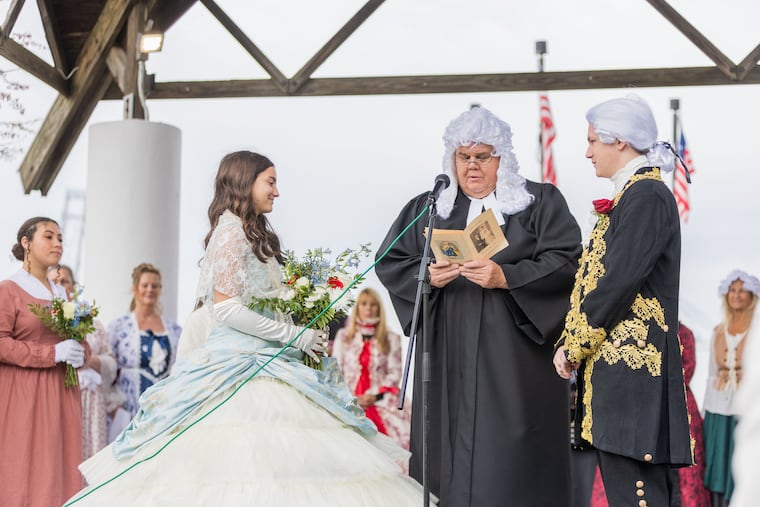Marking her 250th wedding anniversary, Betsy Ross gets hitched with a hitch in Camden County
Did the young re-enactors of Betsy Ross's wedding in 1773 mistakenly get married on Saturday?

It was one of those “Wait, did that just happen?” moments.
On Saturday, two 17-year-olds from Gloucester City High School had just reenacted Betsy Ross’s wedding ceremony in Proprietor’s Park on the former site of Hugg’s Tavern, where the nuptials took place 250 years ago.
A local man who was playing James Bowman, the justice of the peace from 1773, officiated as bride and groom exchanged vows and rings in the park gazebo above the Delaware River in an event sponsored by Gloucester City’s 2023 Committee.
Out of nowhere, wedding emcee Tom Matthews, former on-air personality for Philadelphia’s WOGL-FM, suddenly intoned, “You know, those two kids are now actually married. So, surprise!”
Turns out that the local man who’d portrayed Bowman was, in fact, Gloucester City Mayor Dayl Baile, vested by the state of New Jersey with the power to join folks in wedlock.
A few of the 200 onlookers who’d gathered for the re-enactment began murmuring: Did two students playing historical figures accidentally marry each other?
“I guess I’m not married now,” said Natalee Azzari of Brooklawn, a cheerleader and history buff who played 21-year-old Elizabeth “Betsy” Griscom on the day of her wedding to John Ross. “Right?”
That’s right, she was ultimately told. You can’t legally marry without a license —the original one of which, it’s believed, was drawn up by William Franklin, Ben’s son.
With that, Azzari, a junior, and Jakob Spotts, a senior from the high school’s drama department who’d played John Ross, went off to the reception.
“I’m starving,” said Azzari, who, in keeping with the trappings of a historic day, is the third-great-granddaughter of Charles W. Weisgerber, the 1893 painter of Birth of Our Nation’s Flag. It depicts Ross holding the flag in front of George Washington and others.
Rebel spirit
Although the reenactors couldn’t claim kinship to Ross, three other people at the ceremony could.
John R. Harker, 71, of Mount Vernon, Maine, is the fourth-great-grandson of Ross. He was there with his son, John C., 45, of Maplewood, in Essex County, N.J., and his daughter, Erin Harker Fife, 42, of Concord, Mass.
Both male Harkers were dressed in 18th-century attire; John C. walked Azzari down the aisle during the ceremony.
Touching on a point of contention, John R. emphasized that “Betsy Ross did not design America’s first flag. But she did create the first flag after George Washington had visited her in Philadelphia and asked her to.”
Historically, people differ on that point, with many saying there’s no definitive proof that Ross, an upholsterer, sewed the first flag.
The Harkers won’t have it.
“Even in her own time, people knew what she did,” John R. said. “She was a legend even back then.”
Aside from her patriotic sewing, Fife said she admires Ross’s rebel spirit.
“Having a strong, independent woman in your family history is something I really appreciate, for myself and my two children,” she said.
Ross, who would become an independent businesswoman, had demonstrated tremendous will and inner strength, Fife said, by eloping with John, the son of an Episcopal minister, from Philadelphia to Gloucester City, where she’d been born. Her Quaker family had forbidden her from marrying outside her religion.
Ross was also courageous for backing the American patriots against the British king, something not all Quakers did, John R. said. “She was more pro-revolution than other Quakers,” he added.
John Ross died in 1775 fighting the Revolutionary War, as did Betsy’s second husband, Joseph Ashburn, in 1780. Betsy, who lived until 1836, also outlived her third husband, John Claypoole, who died in 1817.
The Saturday “wedding” — and subsequent reception at the local Elizabeth Ballroom — turned out to be “huge successes” for Gloucester City, which has been celebrating its own 400th anniversary all year, according to Joe Hargesheimer, 76, a former detective lieutenant in the city’s police force. He was listed in the reenactment program as the day’s official wedding planner.
“We’re very proud that Betsy Ross was born here and became such a national icon,” he said. “That’s why we can call this, ‘The small city with a big history.’”
And, Hargesheimer hastened to add, “Tell people Tom Matthews was only kidding. The kids reenacting the wedding today really didn’t get married.”